Analyzing Strategic Planning for Employment Efficiency in SMEs
VerifiedAdded on 2023/06/12
|14
|3875
|72
Report
AI Summary
This report explores the crucial role of strategic planning in enhancing employment efficiency within small and medium-sized enterprises (SMEs) and new ventures. It addresses the problem of lacking strategic planning in SMEs, highlighting its importance for achieving organizational goals and long-term growth. The research aims to analyze the characteristics of strategic development in SMEs, the nature of strategic planning, and the role of entrepreneurs. Through literature review and survey methods, the report investigates why SMEs often underutilize strategic planning compared to larger companies, whether strategic planning correlates with SME success, and how strategic planning relates to company size. Key areas covered include the role of the entrepreneur, strategic planning in young SMEs, core competencies, and how SMEs can effectively plan strategically, ultimately emphasizing the need for SMEs to develop robust plans for future progress and success. This document is available on Desklib, a platform offering a wide range of study tools and resources for students.

Running head: EMPLOYMENT EFFICIENCY
Employment efficiency
Name of the student
Name of the university
Author note
Employment efficiency
Name of the student
Name of the university
Author note
Paraphrase This Document
Need a fresh take? Get an instant paraphrase of this document with our AI Paraphraser
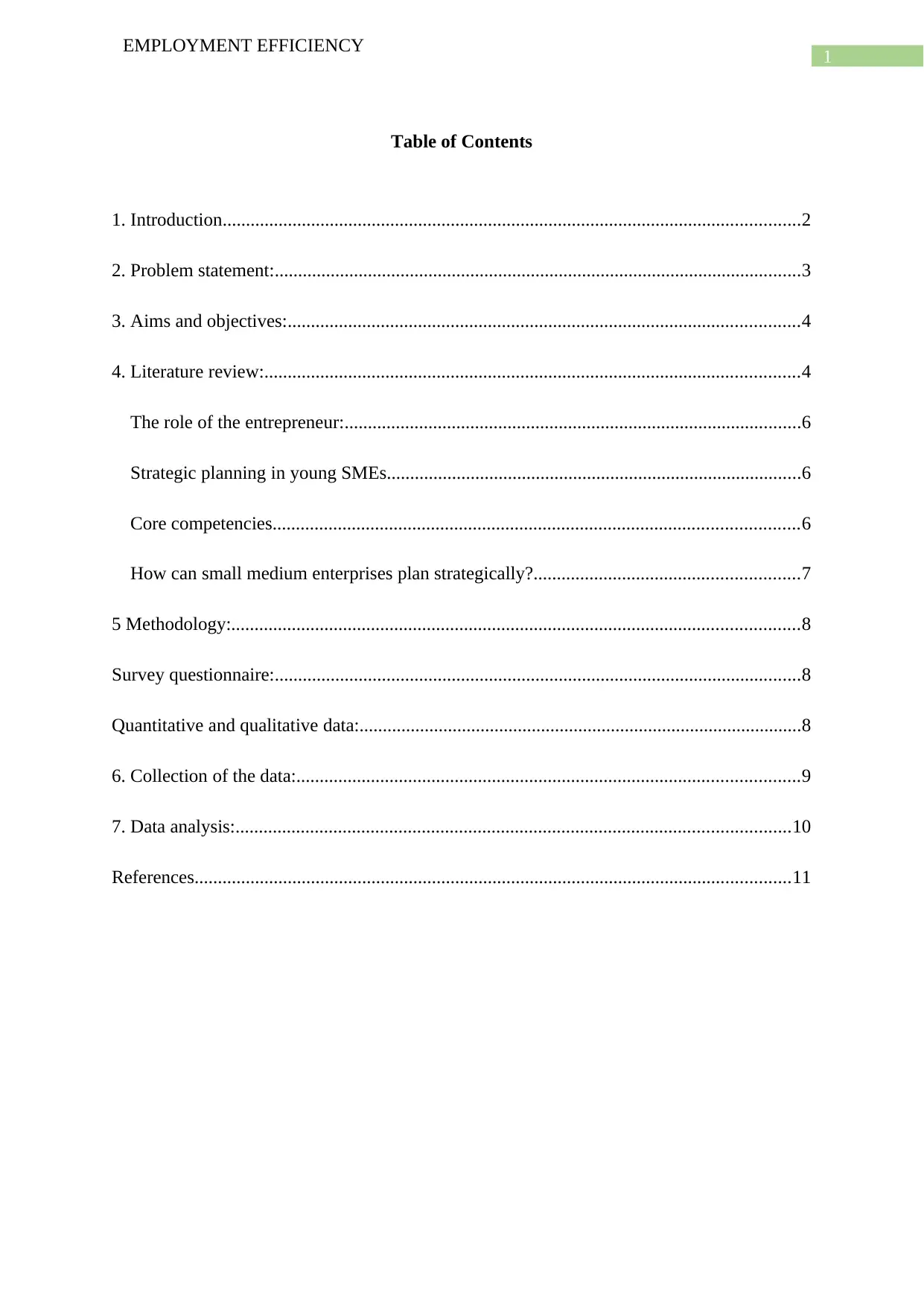
1
EMPLOYMENT EFFICIENCY
Table of Contents
1. Introduction............................................................................................................................2
2. Problem statement:.................................................................................................................3
3. Aims and objectives:..............................................................................................................4
4. Literature review:...................................................................................................................4
The role of the entrepreneur:..................................................................................................6
Strategic planning in young SMEs.........................................................................................6
Core competencies.................................................................................................................6
How can small medium enterprises plan strategically?.........................................................7
5 Methodology:..........................................................................................................................8
Survey questionnaire:.................................................................................................................8
Quantitative and qualitative data:...............................................................................................8
6. Collection of the data:............................................................................................................9
7. Data analysis:.......................................................................................................................10
References................................................................................................................................11
EMPLOYMENT EFFICIENCY
Table of Contents
1. Introduction............................................................................................................................2
2. Problem statement:.................................................................................................................3
3. Aims and objectives:..............................................................................................................4
4. Literature review:...................................................................................................................4
The role of the entrepreneur:..................................................................................................6
Strategic planning in young SMEs.........................................................................................6
Core competencies.................................................................................................................6
How can small medium enterprises plan strategically?.........................................................7
5 Methodology:..........................................................................................................................8
Survey questionnaire:.................................................................................................................8
Quantitative and qualitative data:...............................................................................................8
6. Collection of the data:............................................................................................................9
7. Data analysis:.......................................................................................................................10
References................................................................................................................................11

2
EMPLOYMENT EFFICIENCY
1. Introduction
The small and medium sized enterprises require major knowledge of business in order
to make a successful achievements. It has been observed that usually the SME fails to have a
professional strategic plan. The formal plan and the cost control plans are provided on an
irregular basis. This is the most common shortcomings of the SME. This acts as an
emergence of the strategic planning for the small and medium enterprises. The report
concentrates on the importance of the strategic planning in the new ventures and Young
SME. The report is a study of the research that has been made mentioned earlier. The most
important part of the same is the decision making process. The decision making should
prevail in all the enterprise regardless of their size, practitioners and academics. There is a
link between strategic planning and success. The SMEs do not have the option of ensuring
the successful continuation application of strategic planning. There is a big difference
between the SMEs and big organizations. The SMEs maintain a lower level of resources.
They have limited access to human, financial and customer capital and lack of well-
developed administration. This is the reason the application of formal planning is usually
missing. The study concentrates on the extent to which the SME apply the strategic planning
and the report consists of how they apply the same within the scope of their business activity.
The major portion of the report concentrates on the importance of strategic planning in the
SME (Blackburn, Hart and Wainwright 2013).
There are few aspects that are related to this that has formed a major part of the report.
It include the reason of less planning by the SME compared to the large companies, the fact
whether the strategic planning and the SME success correlate with each other and the fact
whether the strategic planning is a function of increasing the size of the company. The SME
continued to play a major role in the major economies around the globe. They employee more
than half of all the private-sector employees across the globe. As defined by most of the
EMPLOYMENT EFFICIENCY
1. Introduction
The small and medium sized enterprises require major knowledge of business in order
to make a successful achievements. It has been observed that usually the SME fails to have a
professional strategic plan. The formal plan and the cost control plans are provided on an
irregular basis. This is the most common shortcomings of the SME. This acts as an
emergence of the strategic planning for the small and medium enterprises. The report
concentrates on the importance of the strategic planning in the new ventures and Young
SME. The report is a study of the research that has been made mentioned earlier. The most
important part of the same is the decision making process. The decision making should
prevail in all the enterprise regardless of their size, practitioners and academics. There is a
link between strategic planning and success. The SMEs do not have the option of ensuring
the successful continuation application of strategic planning. There is a big difference
between the SMEs and big organizations. The SMEs maintain a lower level of resources.
They have limited access to human, financial and customer capital and lack of well-
developed administration. This is the reason the application of formal planning is usually
missing. The study concentrates on the extent to which the SME apply the strategic planning
and the report consists of how they apply the same within the scope of their business activity.
The major portion of the report concentrates on the importance of strategic planning in the
SME (Blackburn, Hart and Wainwright 2013).
There are few aspects that are related to this that has formed a major part of the report.
It include the reason of less planning by the SME compared to the large companies, the fact
whether the strategic planning and the SME success correlate with each other and the fact
whether the strategic planning is a function of increasing the size of the company. The SME
continued to play a major role in the major economies around the globe. They employee more
than half of all the private-sector employees across the globe. As defined by most of the
⊘ This is a preview!⊘
Do you want full access?
Subscribe today to unlock all pages.

Trusted by 1+ million students worldwide
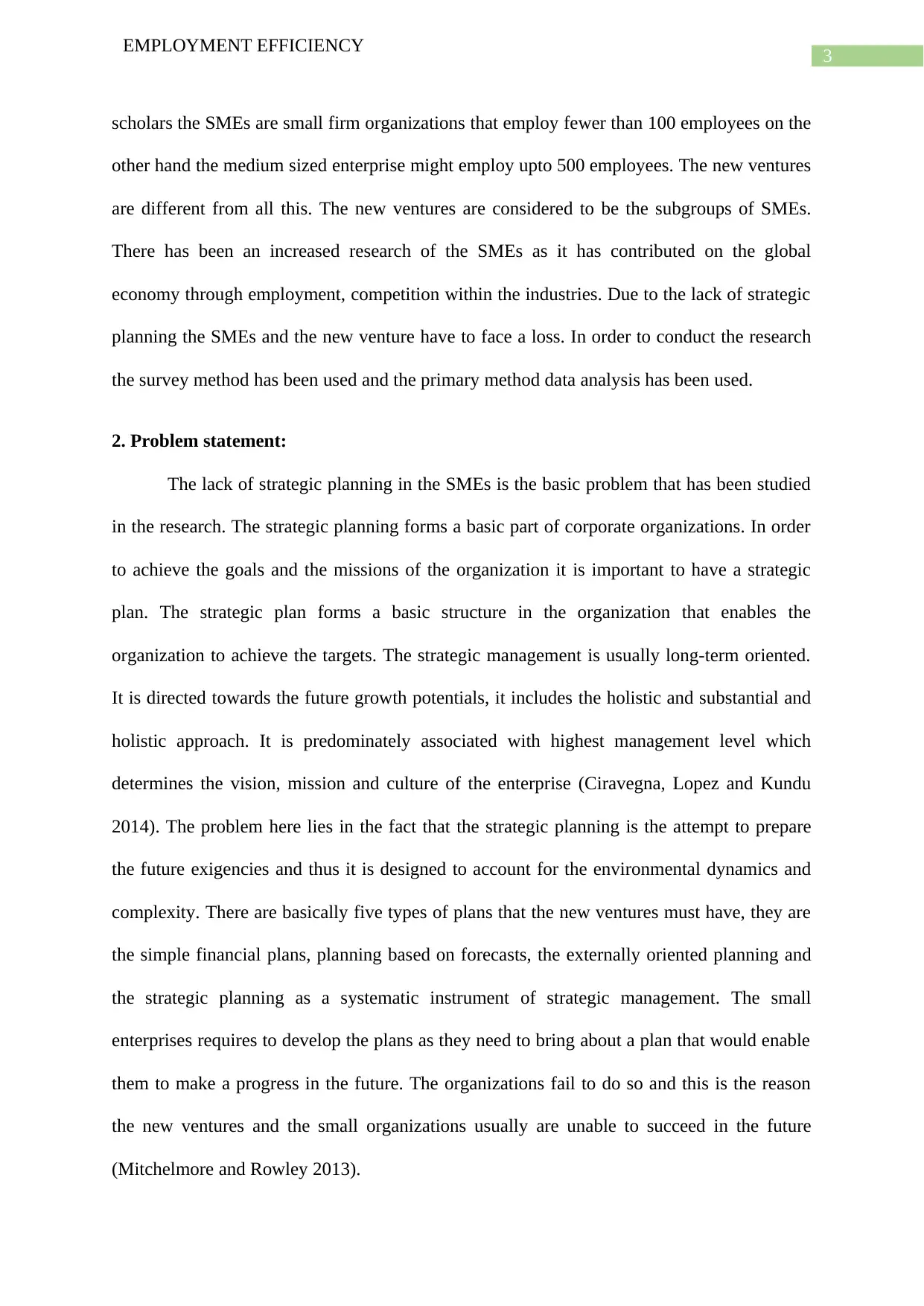
3
EMPLOYMENT EFFICIENCY
scholars the SMEs are small firm organizations that employ fewer than 100 employees on the
other hand the medium sized enterprise might employ upto 500 employees. The new ventures
are different from all this. The new ventures are considered to be the subgroups of SMEs.
There has been an increased research of the SMEs as it has contributed on the global
economy through employment, competition within the industries. Due to the lack of strategic
planning the SMEs and the new venture have to face a loss. In order to conduct the research
the survey method has been used and the primary method data analysis has been used.
2. Problem statement:
The lack of strategic planning in the SMEs is the basic problem that has been studied
in the research. The strategic planning forms a basic part of corporate organizations. In order
to achieve the goals and the missions of the organization it is important to have a strategic
plan. The strategic plan forms a basic structure in the organization that enables the
organization to achieve the targets. The strategic management is usually long-term oriented.
It is directed towards the future growth potentials, it includes the holistic and substantial and
holistic approach. It is predominately associated with highest management level which
determines the vision, mission and culture of the enterprise (Ciravegna, Lopez and Kundu
2014). The problem here lies in the fact that the strategic planning is the attempt to prepare
the future exigencies and thus it is designed to account for the environmental dynamics and
complexity. There are basically five types of plans that the new ventures must have, they are
the simple financial plans, planning based on forecasts, the externally oriented planning and
the strategic planning as a systematic instrument of strategic management. The small
enterprises requires to develop the plans as they need to bring about a plan that would enable
them to make a progress in the future. The organizations fail to do so and this is the reason
the new ventures and the small organizations usually are unable to succeed in the future
(Mitchelmore and Rowley 2013).
EMPLOYMENT EFFICIENCY
scholars the SMEs are small firm organizations that employ fewer than 100 employees on the
other hand the medium sized enterprise might employ upto 500 employees. The new ventures
are different from all this. The new ventures are considered to be the subgroups of SMEs.
There has been an increased research of the SMEs as it has contributed on the global
economy through employment, competition within the industries. Due to the lack of strategic
planning the SMEs and the new venture have to face a loss. In order to conduct the research
the survey method has been used and the primary method data analysis has been used.
2. Problem statement:
The lack of strategic planning in the SMEs is the basic problem that has been studied
in the research. The strategic planning forms a basic part of corporate organizations. In order
to achieve the goals and the missions of the organization it is important to have a strategic
plan. The strategic plan forms a basic structure in the organization that enables the
organization to achieve the targets. The strategic management is usually long-term oriented.
It is directed towards the future growth potentials, it includes the holistic and substantial and
holistic approach. It is predominately associated with highest management level which
determines the vision, mission and culture of the enterprise (Ciravegna, Lopez and Kundu
2014). The problem here lies in the fact that the strategic planning is the attempt to prepare
the future exigencies and thus it is designed to account for the environmental dynamics and
complexity. There are basically five types of plans that the new ventures must have, they are
the simple financial plans, planning based on forecasts, the externally oriented planning and
the strategic planning as a systematic instrument of strategic management. The small
enterprises requires to develop the plans as they need to bring about a plan that would enable
them to make a progress in the future. The organizations fail to do so and this is the reason
the new ventures and the small organizations usually are unable to succeed in the future
(Mitchelmore and Rowley 2013).
Paraphrase This Document
Need a fresh take? Get an instant paraphrase of this document with our AI Paraphraser
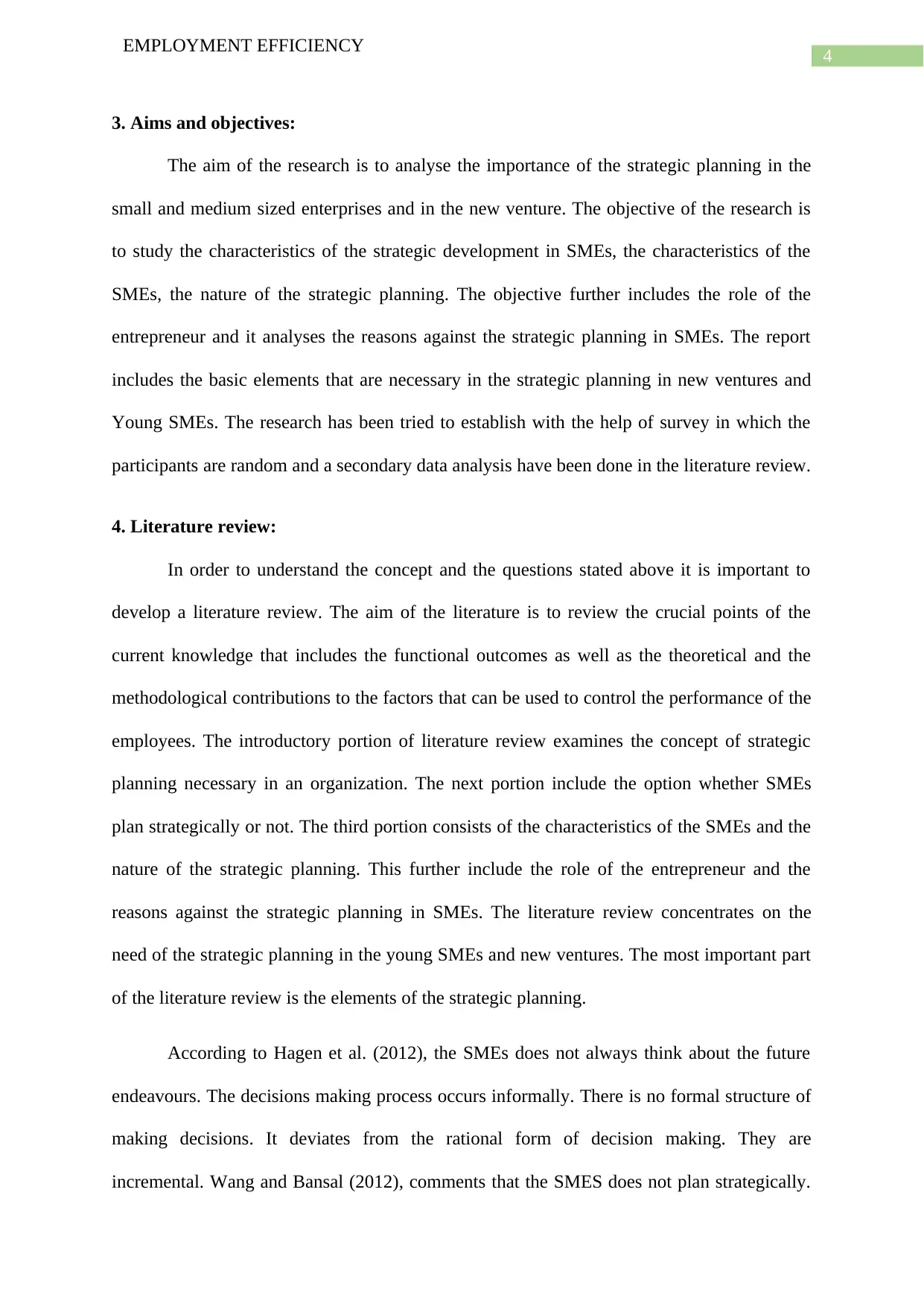
4
EMPLOYMENT EFFICIENCY
3. Aims and objectives:
The aim of the research is to analyse the importance of the strategic planning in the
small and medium sized enterprises and in the new venture. The objective of the research is
to study the characteristics of the strategic development in SMEs, the characteristics of the
SMEs, the nature of the strategic planning. The objective further includes the role of the
entrepreneur and it analyses the reasons against the strategic planning in SMEs. The report
includes the basic elements that are necessary in the strategic planning in new ventures and
Young SMEs. The research has been tried to establish with the help of survey in which the
participants are random and a secondary data analysis have been done in the literature review.
4. Literature review:
In order to understand the concept and the questions stated above it is important to
develop a literature review. The aim of the literature is to review the crucial points of the
current knowledge that includes the functional outcomes as well as the theoretical and the
methodological contributions to the factors that can be used to control the performance of the
employees. The introductory portion of literature review examines the concept of strategic
planning necessary in an organization. The next portion include the option whether SMEs
plan strategically or not. The third portion consists of the characteristics of the SMEs and the
nature of the strategic planning. This further include the role of the entrepreneur and the
reasons against the strategic planning in SMEs. The literature review concentrates on the
need of the strategic planning in the young SMEs and new ventures. The most important part
of the literature review is the elements of the strategic planning.
According to Hagen et al. (2012), the SMEs does not always think about the future
endeavours. The decisions making process occurs informally. There is no formal structure of
making decisions. It deviates from the rational form of decision making. They are
incremental. Wang and Bansal (2012), comments that the SMES does not plan strategically.
EMPLOYMENT EFFICIENCY
3. Aims and objectives:
The aim of the research is to analyse the importance of the strategic planning in the
small and medium sized enterprises and in the new venture. The objective of the research is
to study the characteristics of the strategic development in SMEs, the characteristics of the
SMEs, the nature of the strategic planning. The objective further includes the role of the
entrepreneur and it analyses the reasons against the strategic planning in SMEs. The report
includes the basic elements that are necessary in the strategic planning in new ventures and
Young SMEs. The research has been tried to establish with the help of survey in which the
participants are random and a secondary data analysis have been done in the literature review.
4. Literature review:
In order to understand the concept and the questions stated above it is important to
develop a literature review. The aim of the literature is to review the crucial points of the
current knowledge that includes the functional outcomes as well as the theoretical and the
methodological contributions to the factors that can be used to control the performance of the
employees. The introductory portion of literature review examines the concept of strategic
planning necessary in an organization. The next portion include the option whether SMEs
plan strategically or not. The third portion consists of the characteristics of the SMEs and the
nature of the strategic planning. This further include the role of the entrepreneur and the
reasons against the strategic planning in SMEs. The literature review concentrates on the
need of the strategic planning in the young SMEs and new ventures. The most important part
of the literature review is the elements of the strategic planning.
According to Hagen et al. (2012), the SMEs does not always think about the future
endeavours. The decisions making process occurs informally. There is no formal structure of
making decisions. It deviates from the rational form of decision making. They are
incremental. Wang and Bansal (2012), comments that the SMES does not plan strategically.
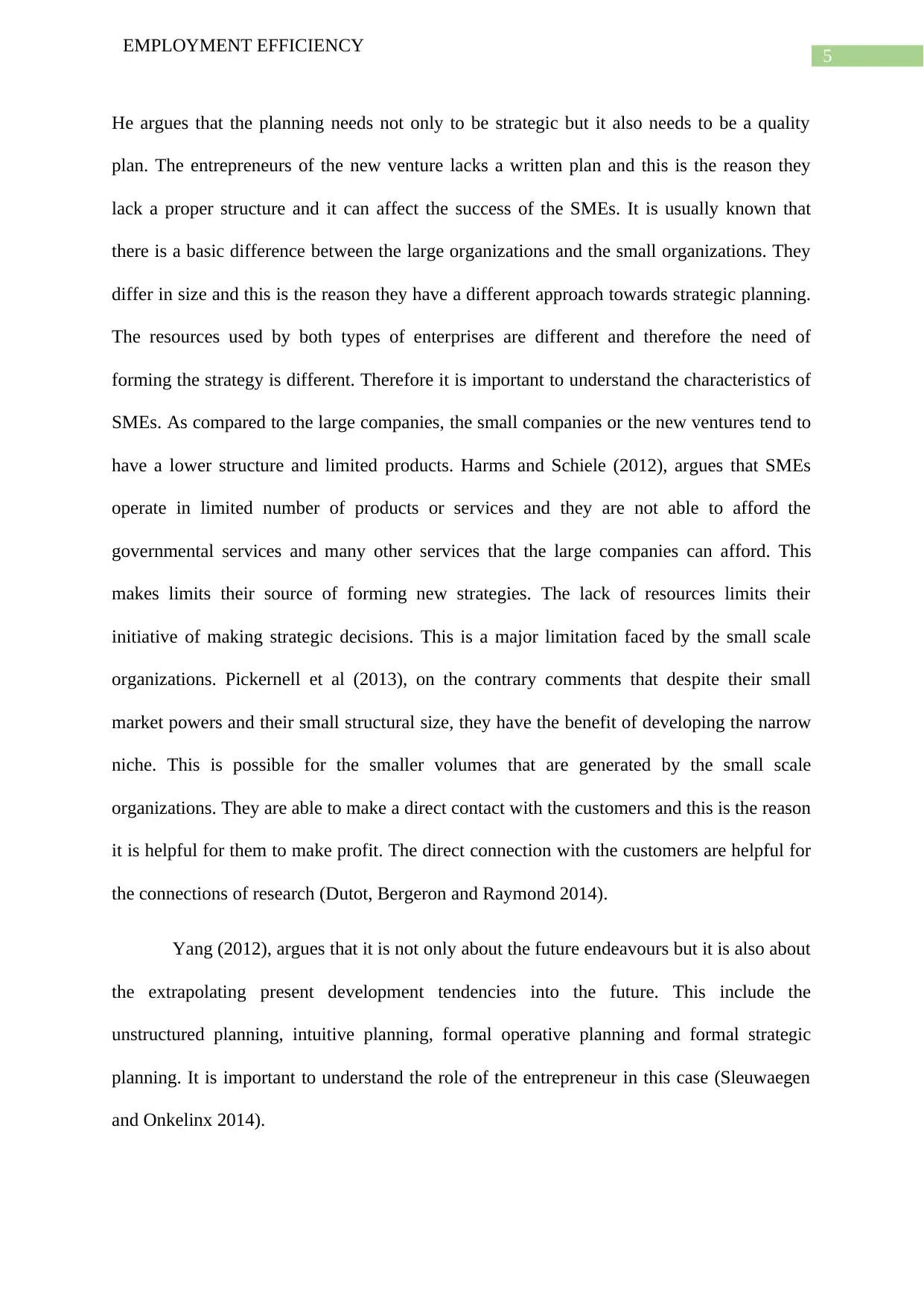
5
EMPLOYMENT EFFICIENCY
He argues that the planning needs not only to be strategic but it also needs to be a quality
plan. The entrepreneurs of the new venture lacks a written plan and this is the reason they
lack a proper structure and it can affect the success of the SMEs. It is usually known that
there is a basic difference between the large organizations and the small organizations. They
differ in size and this is the reason they have a different approach towards strategic planning.
The resources used by both types of enterprises are different and therefore the need of
forming the strategy is different. Therefore it is important to understand the characteristics of
SMEs. As compared to the large companies, the small companies or the new ventures tend to
have a lower structure and limited products. Harms and Schiele (2012), argues that SMEs
operate in limited number of products or services and they are not able to afford the
governmental services and many other services that the large companies can afford. This
makes limits their source of forming new strategies. The lack of resources limits their
initiative of making strategic decisions. This is a major limitation faced by the small scale
organizations. Pickernell et al (2013), on the contrary comments that despite their small
market powers and their small structural size, they have the benefit of developing the narrow
niche. This is possible for the smaller volumes that are generated by the small scale
organizations. They are able to make a direct contact with the customers and this is the reason
it is helpful for them to make profit. The direct connection with the customers are helpful for
the connections of research (Dutot, Bergeron and Raymond 2014).
Yang (2012), argues that it is not only about the future endeavours but it is also about
the extrapolating present development tendencies into the future. This include the
unstructured planning, intuitive planning, formal operative planning and formal strategic
planning. It is important to understand the role of the entrepreneur in this case (Sleuwaegen
and Onkelinx 2014).
EMPLOYMENT EFFICIENCY
He argues that the planning needs not only to be strategic but it also needs to be a quality
plan. The entrepreneurs of the new venture lacks a written plan and this is the reason they
lack a proper structure and it can affect the success of the SMEs. It is usually known that
there is a basic difference between the large organizations and the small organizations. They
differ in size and this is the reason they have a different approach towards strategic planning.
The resources used by both types of enterprises are different and therefore the need of
forming the strategy is different. Therefore it is important to understand the characteristics of
SMEs. As compared to the large companies, the small companies or the new ventures tend to
have a lower structure and limited products. Harms and Schiele (2012), argues that SMEs
operate in limited number of products or services and they are not able to afford the
governmental services and many other services that the large companies can afford. This
makes limits their source of forming new strategies. The lack of resources limits their
initiative of making strategic decisions. This is a major limitation faced by the small scale
organizations. Pickernell et al (2013), on the contrary comments that despite their small
market powers and their small structural size, they have the benefit of developing the narrow
niche. This is possible for the smaller volumes that are generated by the small scale
organizations. They are able to make a direct contact with the customers and this is the reason
it is helpful for them to make profit. The direct connection with the customers are helpful for
the connections of research (Dutot, Bergeron and Raymond 2014).
Yang (2012), argues that it is not only about the future endeavours but it is also about
the extrapolating present development tendencies into the future. This include the
unstructured planning, intuitive planning, formal operative planning and formal strategic
planning. It is important to understand the role of the entrepreneur in this case (Sleuwaegen
and Onkelinx 2014).
⊘ This is a preview!⊘
Do you want full access?
Subscribe today to unlock all pages.

Trusted by 1+ million students worldwide
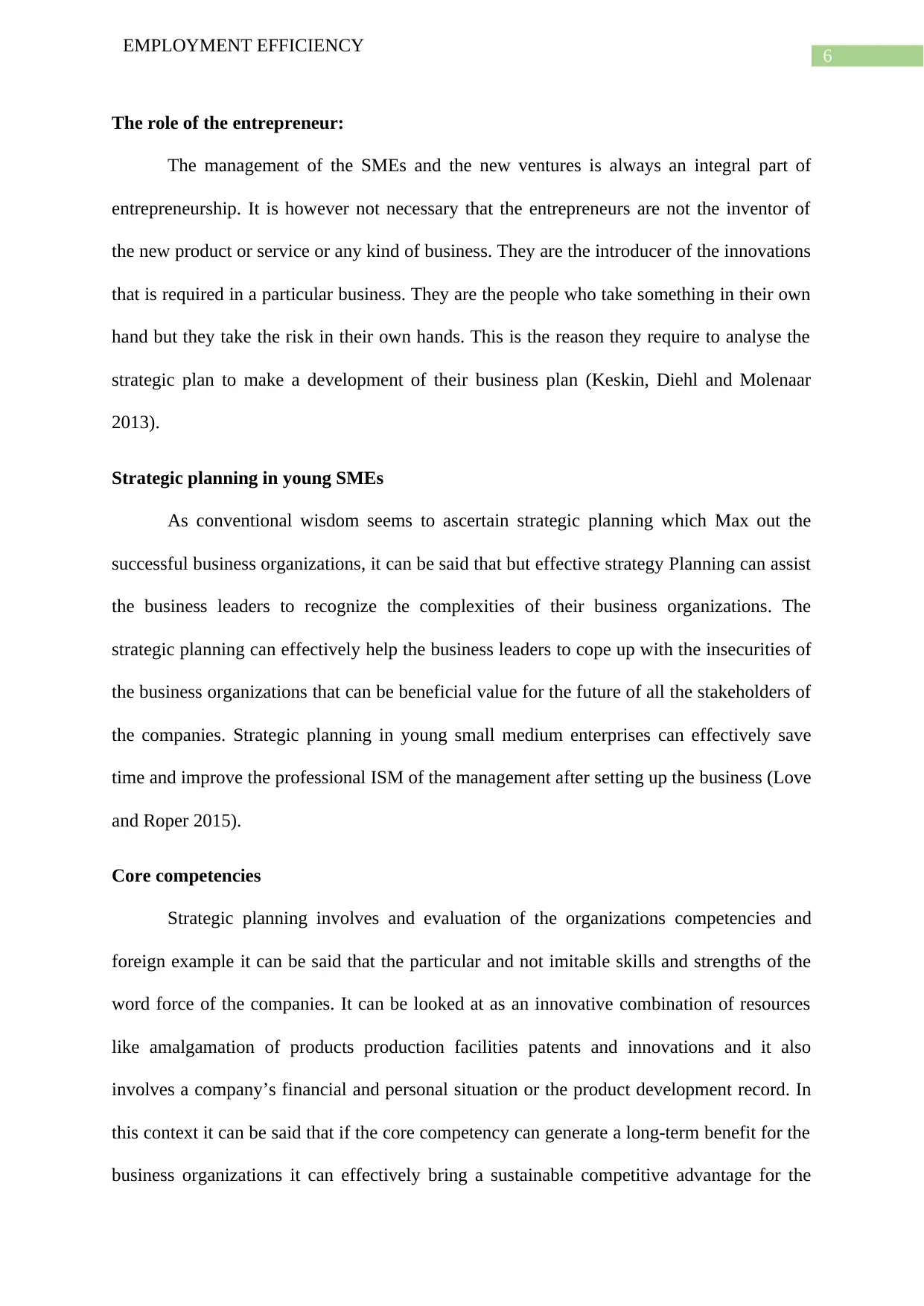
6
EMPLOYMENT EFFICIENCY
The role of the entrepreneur:
The management of the SMEs and the new ventures is always an integral part of
entrepreneurship. It is however not necessary that the entrepreneurs are not the inventor of
the new product or service or any kind of business. They are the introducer of the innovations
that is required in a particular business. They are the people who take something in their own
hand but they take the risk in their own hands. This is the reason they require to analyse the
strategic plan to make a development of their business plan (Keskin, Diehl and Molenaar
2013).
Strategic planning in young SMEs
As conventional wisdom seems to ascertain strategic planning which Max out the
successful business organizations, it can be said that but effective strategy Planning can assist
the business leaders to recognize the complexities of their business organizations. The
strategic planning can effectively help the business leaders to cope up with the insecurities of
the business organizations that can be beneficial value for the future of all the stakeholders of
the companies. Strategic planning in young small medium enterprises can effectively save
time and improve the professional ISM of the management after setting up the business (Love
and Roper 2015).
Core competencies
Strategic planning involves and evaluation of the organizations competencies and
foreign example it can be said that the particular and not imitable skills and strengths of the
word force of the companies. It can be looked at as an innovative combination of resources
like amalgamation of products production facilities patents and innovations and it also
involves a company’s financial and personal situation or the product development record. In
this context it can be said that if the core competency can generate a long-term benefit for the
business organizations it can effectively bring a sustainable competitive advantage for the
EMPLOYMENT EFFICIENCY
The role of the entrepreneur:
The management of the SMEs and the new ventures is always an integral part of
entrepreneurship. It is however not necessary that the entrepreneurs are not the inventor of
the new product or service or any kind of business. They are the introducer of the innovations
that is required in a particular business. They are the people who take something in their own
hand but they take the risk in their own hands. This is the reason they require to analyse the
strategic plan to make a development of their business plan (Keskin, Diehl and Molenaar
2013).
Strategic planning in young SMEs
As conventional wisdom seems to ascertain strategic planning which Max out the
successful business organizations, it can be said that but effective strategy Planning can assist
the business leaders to recognize the complexities of their business organizations. The
strategic planning can effectively help the business leaders to cope up with the insecurities of
the business organizations that can be beneficial value for the future of all the stakeholders of
the companies. Strategic planning in young small medium enterprises can effectively save
time and improve the professional ISM of the management after setting up the business (Love
and Roper 2015).
Core competencies
Strategic planning involves and evaluation of the organizations competencies and
foreign example it can be said that the particular and not imitable skills and strengths of the
word force of the companies. It can be looked at as an innovative combination of resources
like amalgamation of products production facilities patents and innovations and it also
involves a company’s financial and personal situation or the product development record. In
this context it can be said that if the core competency can generate a long-term benefit for the
business organizations it can effectively bring a sustainable competitive advantage for the
Paraphrase This Document
Need a fresh take? Get an instant paraphrase of this document with our AI Paraphraser

7
EMPLOYMENT EFFICIENCY
management of the organization in the market full of competition. It is a matter of fact that
the core competence is the innovation upon which the management of the business
organizations established their business model to secure profitability and for an example it
can be said that innovative and noble products are the services are the key elements for the
business organizations to secure their profitability along with productivity (Kuivalainen,
Saarenketo and Puumalainen 2012).
How can small medium enterprises plan strategically?
It can be assume that individual so work for small and medium enterprises should
think strategically as due to the well accepted view that the strategies can we meet the
Enterprises’ scopes to generate more productivity and profitability and therefore by
decreasing the flexibility many small Enterprises or medium enterprises are lagging behind
due to not having the capability to implement effective strategic plans. Therefore it can be
stated that strategic awareness and involvement of the management of the organizations in
strategic planning is the key to achieve success in the market full of competition and it can
also be said that lack of formal strategic planning can become a barrier in the path of
achieving success for the small and medium enterprises (Gică and Balint 2012). In this regard
it is worthwhile to mention that to implement strategic planning and to undergo a change in
the organizational structure the management will have to have the capability to control the
entire workforce and for that a strong leadership is necessary. Not only that effective
communication should be established in the workplace so that it can enable sharing of
knowledge and experiences among the entire workforce which is important to improve the
organizational performance. It is a matter of fact that strategic planning can be a substantial
factor for small or medium scale business Enterprises and it can be said that the best business
plans are only effective if they are implemented properly and organizational performance is
EMPLOYMENT EFFICIENCY
management of the organization in the market full of competition. It is a matter of fact that
the core competence is the innovation upon which the management of the business
organizations established their business model to secure profitability and for an example it
can be said that innovative and noble products are the services are the key elements for the
business organizations to secure their profitability along with productivity (Kuivalainen,
Saarenketo and Puumalainen 2012).
How can small medium enterprises plan strategically?
It can be assume that individual so work for small and medium enterprises should
think strategically as due to the well accepted view that the strategies can we meet the
Enterprises’ scopes to generate more productivity and profitability and therefore by
decreasing the flexibility many small Enterprises or medium enterprises are lagging behind
due to not having the capability to implement effective strategic plans. Therefore it can be
stated that strategic awareness and involvement of the management of the organizations in
strategic planning is the key to achieve success in the market full of competition and it can
also be said that lack of formal strategic planning can become a barrier in the path of
achieving success for the small and medium enterprises (Gică and Balint 2012). In this regard
it is worthwhile to mention that to implement strategic planning and to undergo a change in
the organizational structure the management will have to have the capability to control the
entire workforce and for that a strong leadership is necessary. Not only that effective
communication should be established in the workplace so that it can enable sharing of
knowledge and experiences among the entire workforce which is important to improve the
organizational performance. It is a matter of fact that strategic planning can be a substantial
factor for small or medium scale business Enterprises and it can be said that the best business
plans are only effective if they are implemented properly and organizational performance is
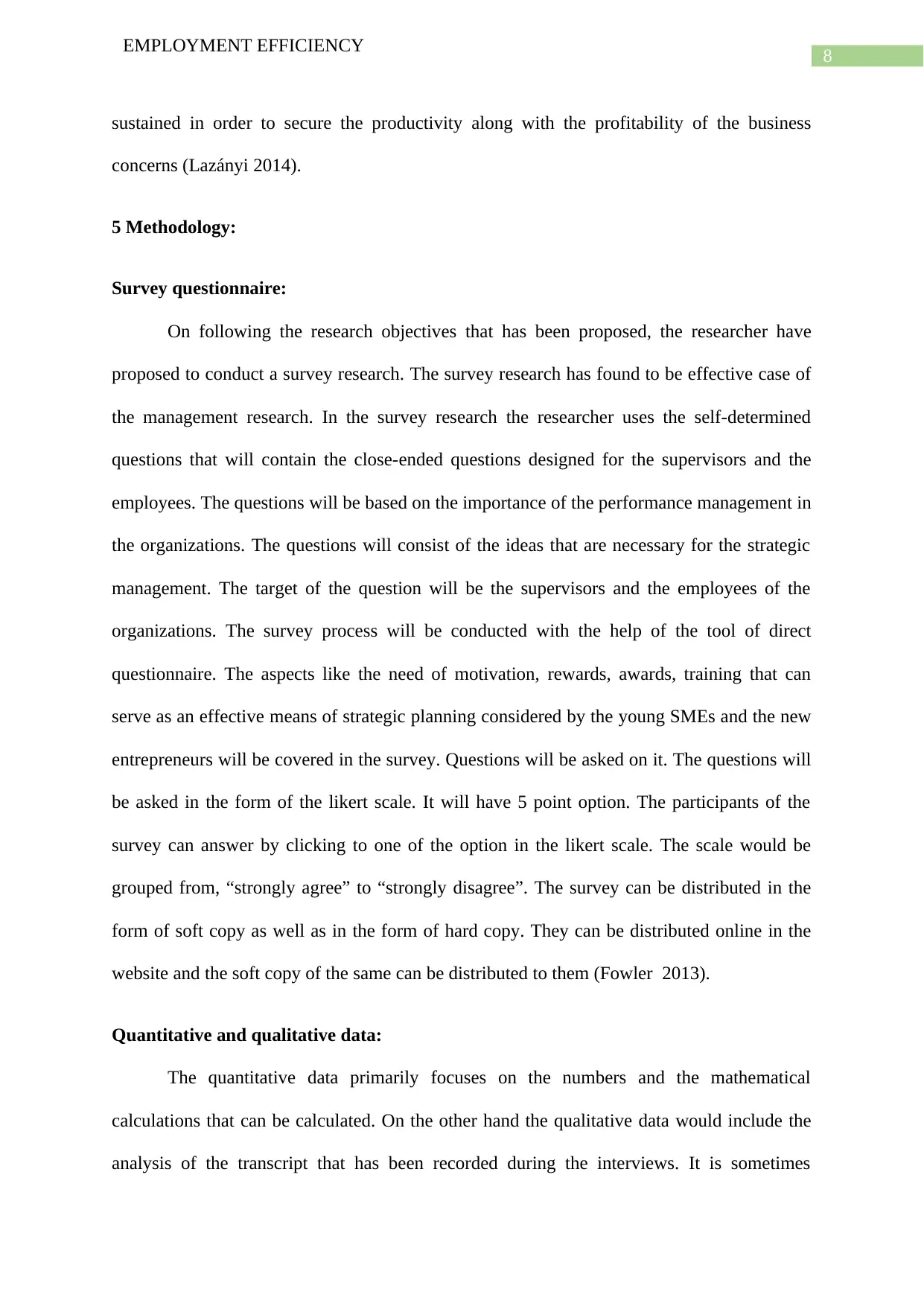
8
EMPLOYMENT EFFICIENCY
sustained in order to secure the productivity along with the profitability of the business
concerns (Lazányi 2014).
5 Methodology:
Survey questionnaire:
On following the research objectives that has been proposed, the researcher have
proposed to conduct a survey research. The survey research has found to be effective case of
the management research. In the survey research the researcher uses the self-determined
questions that will contain the close-ended questions designed for the supervisors and the
employees. The questions will be based on the importance of the performance management in
the organizations. The questions will consist of the ideas that are necessary for the strategic
management. The target of the question will be the supervisors and the employees of the
organizations. The survey process will be conducted with the help of the tool of direct
questionnaire. The aspects like the need of motivation, rewards, awards, training that can
serve as an effective means of strategic planning considered by the young SMEs and the new
entrepreneurs will be covered in the survey. Questions will be asked on it. The questions will
be asked in the form of the likert scale. It will have 5 point option. The participants of the
survey can answer by clicking to one of the option in the likert scale. The scale would be
grouped from, “strongly agree” to “strongly disagree”. The survey can be distributed in the
form of soft copy as well as in the form of hard copy. They can be distributed online in the
website and the soft copy of the same can be distributed to them (Fowler 2013).
Quantitative and qualitative data:
The quantitative data primarily focuses on the numbers and the mathematical
calculations that can be calculated. On the other hand the qualitative data would include the
analysis of the transcript that has been recorded during the interviews. It is sometimes
EMPLOYMENT EFFICIENCY
sustained in order to secure the productivity along with the profitability of the business
concerns (Lazányi 2014).
5 Methodology:
Survey questionnaire:
On following the research objectives that has been proposed, the researcher have
proposed to conduct a survey research. The survey research has found to be effective case of
the management research. In the survey research the researcher uses the self-determined
questions that will contain the close-ended questions designed for the supervisors and the
employees. The questions will be based on the importance of the performance management in
the organizations. The questions will consist of the ideas that are necessary for the strategic
management. The target of the question will be the supervisors and the employees of the
organizations. The survey process will be conducted with the help of the tool of direct
questionnaire. The aspects like the need of motivation, rewards, awards, training that can
serve as an effective means of strategic planning considered by the young SMEs and the new
entrepreneurs will be covered in the survey. Questions will be asked on it. The questions will
be asked in the form of the likert scale. It will have 5 point option. The participants of the
survey can answer by clicking to one of the option in the likert scale. The scale would be
grouped from, “strongly agree” to “strongly disagree”. The survey can be distributed in the
form of soft copy as well as in the form of hard copy. They can be distributed online in the
website and the soft copy of the same can be distributed to them (Fowler 2013).
Quantitative and qualitative data:
The quantitative data primarily focuses on the numbers and the mathematical
calculations that can be calculated. On the other hand the qualitative data would include the
analysis of the transcript that has been recorded during the interviews. It is sometimes
⊘ This is a preview!⊘
Do you want full access?
Subscribe today to unlock all pages.

Trusted by 1+ million students worldwide

9
EMPLOYMENT EFFICIENCY
regarded as the view that has been expressed while researching any case study. This cannot
be calculated as it based on the open-ended questions. The open-ended questions are
descriptive in nature and it cannot be answered in one word. The views of different persons
are recorded in the interviews. In this case an interview can be conducted on the supervisors
and the employees on the factors they think that is important for the development of the
performance of the employees. The idea of the supervisors and the employees has been
recorded in the transcript. The basic difference between the quantitative and quantitative data
is that qualitative data is descriptive in nature and the quantitative data expresses the count of
the values and this is analysed with the use of surveys. In this research the use of quantitative
data will be used by the researcher in order to analyse the extent to which employee
performance can be effectively managed (Nardi 2018).
6. Collection of the data:
The collection of the data can be done by the means of primary and secondary data.
The primary data would include the process of survey. In the survey process the analysis will
be done by taking a particular sample size and the findings can be done on the basis of the
result of the survey. The collection of the data can be done by applying the secondary method
as well. This would include the collection of the secondary sources like the research articles,
magazines, scholarly articles, news articles, peer-reviewed journals, scholarly books,
magazines. This might include the previous research that has been done by the research
scholars. In this study material the data collection process that has been used is the primary
process that is survey questionnaires. The use of secondary data collection method has been
done in the literature review section (McNabb 2015).
EMPLOYMENT EFFICIENCY
regarded as the view that has been expressed while researching any case study. This cannot
be calculated as it based on the open-ended questions. The open-ended questions are
descriptive in nature and it cannot be answered in one word. The views of different persons
are recorded in the interviews. In this case an interview can be conducted on the supervisors
and the employees on the factors they think that is important for the development of the
performance of the employees. The idea of the supervisors and the employees has been
recorded in the transcript. The basic difference between the quantitative and quantitative data
is that qualitative data is descriptive in nature and the quantitative data expresses the count of
the values and this is analysed with the use of surveys. In this research the use of quantitative
data will be used by the researcher in order to analyse the extent to which employee
performance can be effectively managed (Nardi 2018).
6. Collection of the data:
The collection of the data can be done by the means of primary and secondary data.
The primary data would include the process of survey. In the survey process the analysis will
be done by taking a particular sample size and the findings can be done on the basis of the
result of the survey. The collection of the data can be done by applying the secondary method
as well. This would include the collection of the secondary sources like the research articles,
magazines, scholarly articles, news articles, peer-reviewed journals, scholarly books,
magazines. This might include the previous research that has been done by the research
scholars. In this study material the data collection process that has been used is the primary
process that is survey questionnaires. The use of secondary data collection method has been
done in the literature review section (McNabb 2015).
Paraphrase This Document
Need a fresh take? Get an instant paraphrase of this document with our AI Paraphraser
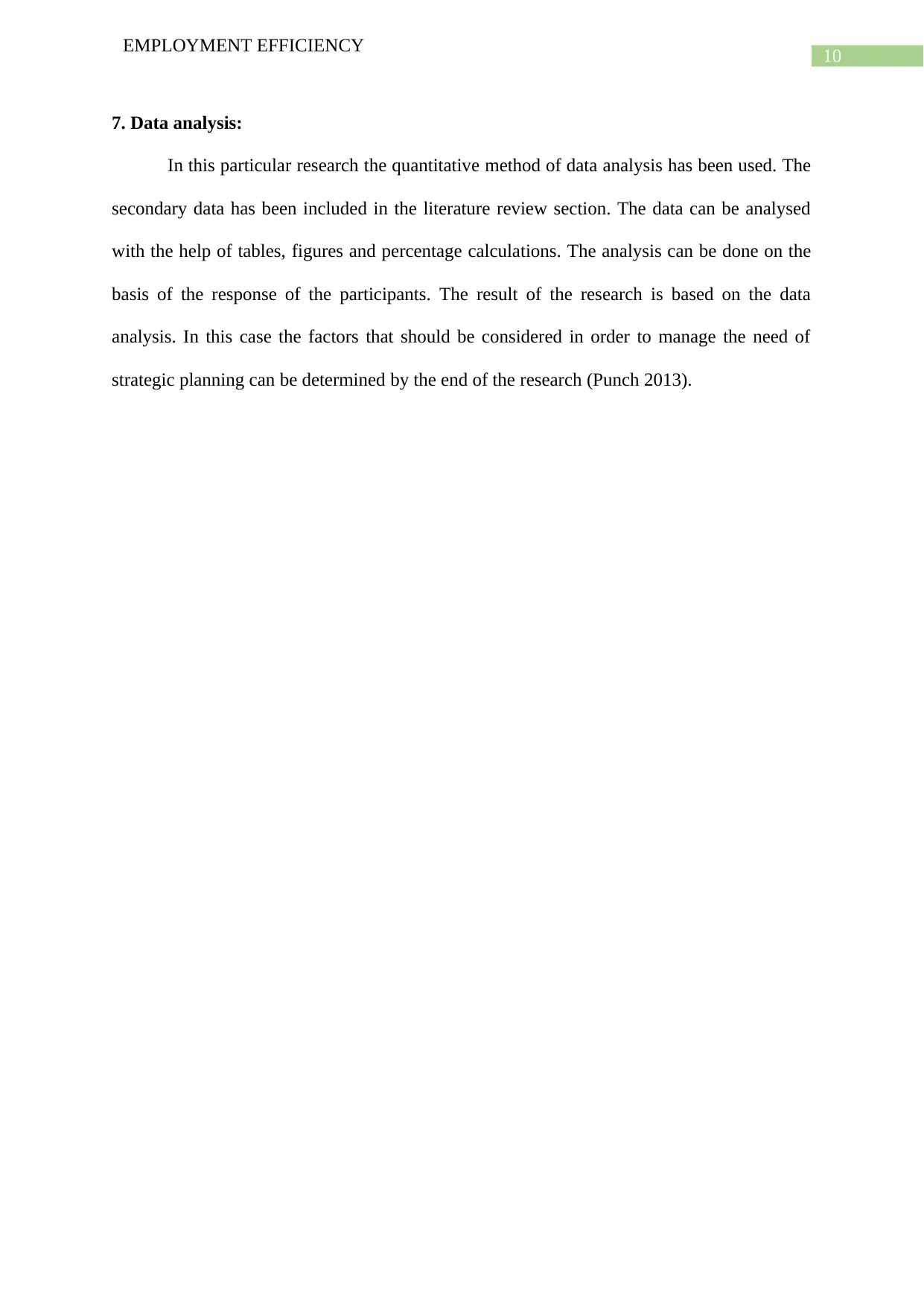
10
EMPLOYMENT EFFICIENCY
7. Data analysis:
In this particular research the quantitative method of data analysis has been used. The
secondary data has been included in the literature review section. The data can be analysed
with the help of tables, figures and percentage calculations. The analysis can be done on the
basis of the response of the participants. The result of the research is based on the data
analysis. In this case the factors that should be considered in order to manage the need of
strategic planning can be determined by the end of the research (Punch 2013).
EMPLOYMENT EFFICIENCY
7. Data analysis:
In this particular research the quantitative method of data analysis has been used. The
secondary data has been included in the literature review section. The data can be analysed
with the help of tables, figures and percentage calculations. The analysis can be done on the
basis of the response of the participants. The result of the research is based on the data
analysis. In this case the factors that should be considered in order to manage the need of
strategic planning can be determined by the end of the research (Punch 2013).
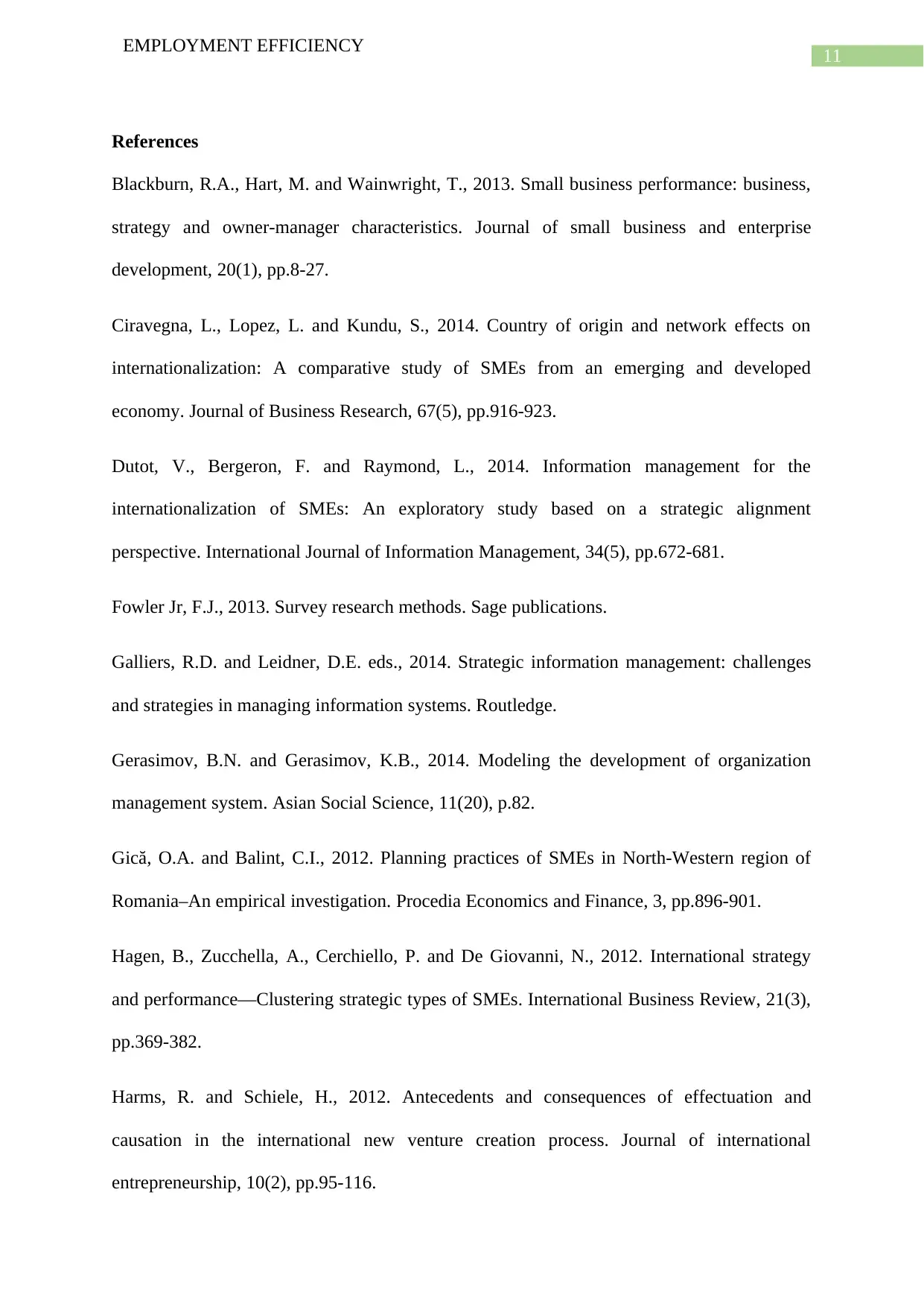
11
EMPLOYMENT EFFICIENCY
References
Blackburn, R.A., Hart, M. and Wainwright, T., 2013. Small business performance: business,
strategy and owner-manager characteristics. Journal of small business and enterprise
development, 20(1), pp.8-27.
Ciravegna, L., Lopez, L. and Kundu, S., 2014. Country of origin and network effects on
internationalization: A comparative study of SMEs from an emerging and developed
economy. Journal of Business Research, 67(5), pp.916-923.
Dutot, V., Bergeron, F. and Raymond, L., 2014. Information management for the
internationalization of SMEs: An exploratory study based on a strategic alignment
perspective. International Journal of Information Management, 34(5), pp.672-681.
Fowler Jr, F.J., 2013. Survey research methods. Sage publications.
Galliers, R.D. and Leidner, D.E. eds., 2014. Strategic information management: challenges
and strategies in managing information systems. Routledge.
Gerasimov, B.N. and Gerasimov, K.B., 2014. Modeling the development of organization
management system. Asian Social Science, 11(20), p.82.
Gică, O.A. and Balint, C.I., 2012. Planning practices of SMEs in North-Western region of
Romania–An empirical investigation. Procedia Economics and Finance, 3, pp.896-901.
Hagen, B., Zucchella, A., Cerchiello, P. and De Giovanni, N., 2012. International strategy
and performance—Clustering strategic types of SMEs. International Business Review, 21(3),
pp.369-382.
Harms, R. and Schiele, H., 2012. Antecedents and consequences of effectuation and
causation in the international new venture creation process. Journal of international
entrepreneurship, 10(2), pp.95-116.
EMPLOYMENT EFFICIENCY
References
Blackburn, R.A., Hart, M. and Wainwright, T., 2013. Small business performance: business,
strategy and owner-manager characteristics. Journal of small business and enterprise
development, 20(1), pp.8-27.
Ciravegna, L., Lopez, L. and Kundu, S., 2014. Country of origin and network effects on
internationalization: A comparative study of SMEs from an emerging and developed
economy. Journal of Business Research, 67(5), pp.916-923.
Dutot, V., Bergeron, F. and Raymond, L., 2014. Information management for the
internationalization of SMEs: An exploratory study based on a strategic alignment
perspective. International Journal of Information Management, 34(5), pp.672-681.
Fowler Jr, F.J., 2013. Survey research methods. Sage publications.
Galliers, R.D. and Leidner, D.E. eds., 2014. Strategic information management: challenges
and strategies in managing information systems. Routledge.
Gerasimov, B.N. and Gerasimov, K.B., 2014. Modeling the development of organization
management system. Asian Social Science, 11(20), p.82.
Gică, O.A. and Balint, C.I., 2012. Planning practices of SMEs in North-Western region of
Romania–An empirical investigation. Procedia Economics and Finance, 3, pp.896-901.
Hagen, B., Zucchella, A., Cerchiello, P. and De Giovanni, N., 2012. International strategy
and performance—Clustering strategic types of SMEs. International Business Review, 21(3),
pp.369-382.
Harms, R. and Schiele, H., 2012. Antecedents and consequences of effectuation and
causation in the international new venture creation process. Journal of international
entrepreneurship, 10(2), pp.95-116.
⊘ This is a preview!⊘
Do you want full access?
Subscribe today to unlock all pages.

Trusted by 1+ million students worldwide
1 out of 14
Related Documents
Your All-in-One AI-Powered Toolkit for Academic Success.
+13062052269
info@desklib.com
Available 24*7 on WhatsApp / Email
![[object Object]](/_next/static/media/star-bottom.7253800d.svg)
Unlock your academic potential
Copyright © 2020–2025 A2Z Services. All Rights Reserved. Developed and managed by ZUCOL.





